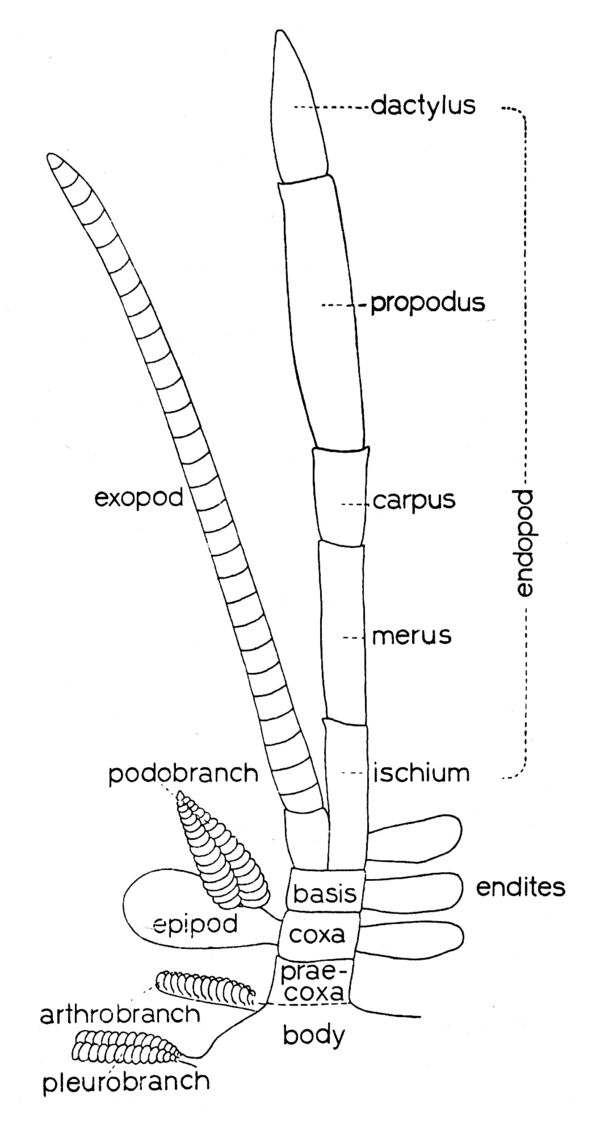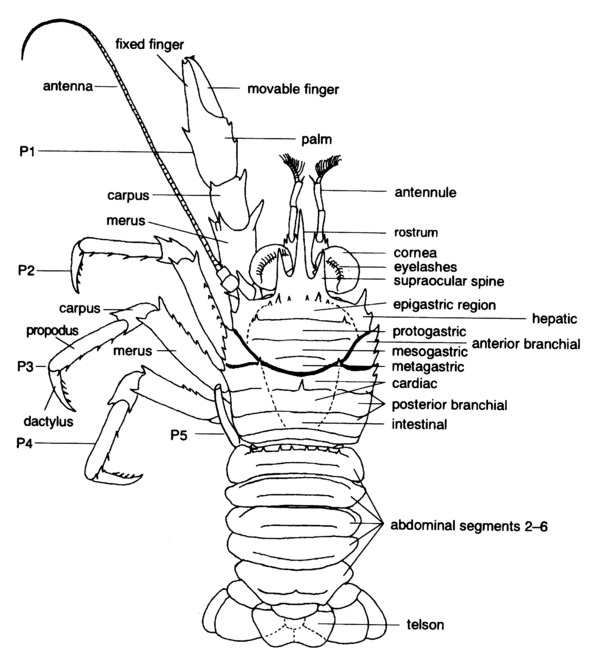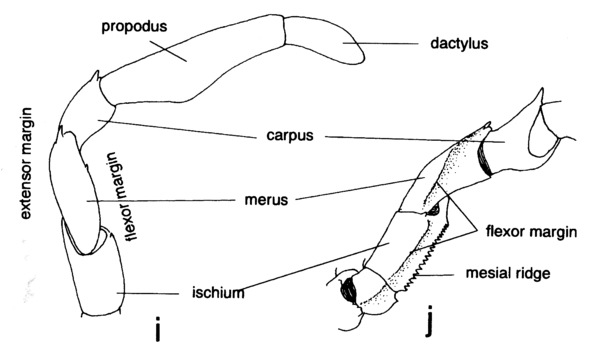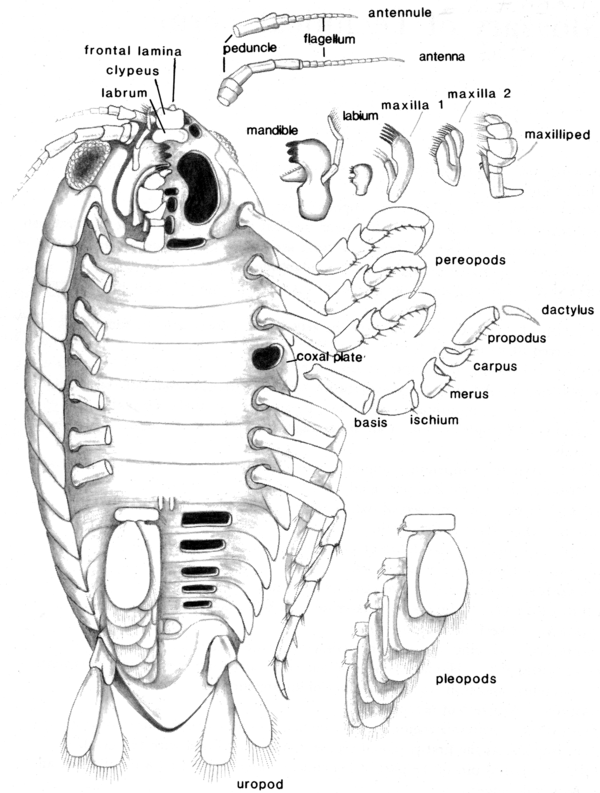- merus
- (
 ) [Holthuis, 1993].Schematic drawing of a thoracic leg. [Holthuis, 1993](
) [Holthuis, 1993].Schematic drawing of a thoracic leg. [Holthuis, 1993]( ) [Baba, 2005].Entire animal, right appendages omitted, dorsal view, based on Munida. [Baba, 2005](
) [Baba, 2005].Entire animal, right appendages omitted, dorsal view, based on Munida. [Baba, 2005]( ) [Baba, 2005].Endopod of Mxp 3, lateral; and endopod of Mxp 3, including basal 2 articles, distal articles omitted, central. Based on Munidopsis. [Baba, 2005]Article 4 of pereopod (article 3 of cheliped) [Holdich and Jones, 1983].Fourth article from distal end of leg; sometimes called arm of cheliped. (Syn. meropodite) [Williams, 1984].Fourth article of limb [Poore, 2004].Fourth limb segment distally from body, its proximal extremity articulating with ischium; usually forms first long segment of cheliped and pereiopod. (Syn. meropod(ite)) [Moore and McCormick, 1969].Fourth segment (distally from body), articulating proximally with ischium and distally with carpus. (Syn. meropod) [McLaughlin, 1980].Fourth segment from proximal end of a typically 7-segmented appendage. (Pl. meri) [Butler, T.H.].Fourth segment from proximal end of segmented appendage [Hobbs and Jass, 1988].Fourth segment of a pereiopod or maxilliped, counted from the distal end [Ingle, 1983].Fouth segment from the proximal end of a typically 7-segmented appendage. (Fig. 3C). (Pl. meri) [Perez Farfante and Kensley, 1997].The 4th podomere from the tip of the endopod of a limb (Figs. 1, 2) [Warner, 1977].The fourth segment from the proximal end of a segmented appendage [Hobbs, Hobbs, and Daniel 1977].The fourth segment from the proximal end of a typically 7-segmented appendage. (Pl. meri) [Chace and Hobbs, 1969].The fourth segment of a thoracic appendage. (Pl. meri) (Syn. meropodite) See: pereopod [Wilson, 1989].(Order Cumacea):Second of five segments (ischium, merus, carpus, propodus, dactylus) of endopod of thoracopod (maxillipeds and pereopods). (Syn. meropod, meropodite) [Stachowitsch, 1992].(Order Tanaidacea):Fourth of basically seven segments (coxa, basis, ischium, merus, carpus, propodus, dactylus) of thoracopod. (Syn. meropod, meropodite) [Stachowitsch, 1992].(Order Decapoda):Fourth segment of appendage (thoracopod); positioned between ischium and carpus. May be fused to ischium to form ischiomerus. (Syn. meropod, meropodite) [Stachowitsch, 1992].(Order Amphipoda):Fourth of basically seven segments (coxa, basis, ischium, merus, carpus propodus, dactylus) of thoracopod; represents third movable (free) segment. (Syn. meropod, meropodite) [Stachowitsch, 1992].(Order Isopoda):Article 4 of pereopod [Kensley and Schotte, 1989].(Order Isopoda):(
) [Baba, 2005].Endopod of Mxp 3, lateral; and endopod of Mxp 3, including basal 2 articles, distal articles omitted, central. Based on Munidopsis. [Baba, 2005]Article 4 of pereopod (article 3 of cheliped) [Holdich and Jones, 1983].Fourth article from distal end of leg; sometimes called arm of cheliped. (Syn. meropodite) [Williams, 1984].Fourth article of limb [Poore, 2004].Fourth limb segment distally from body, its proximal extremity articulating with ischium; usually forms first long segment of cheliped and pereiopod. (Syn. meropod(ite)) [Moore and McCormick, 1969].Fourth segment (distally from body), articulating proximally with ischium and distally with carpus. (Syn. meropod) [McLaughlin, 1980].Fourth segment from proximal end of a typically 7-segmented appendage. (Pl. meri) [Butler, T.H.].Fourth segment from proximal end of segmented appendage [Hobbs and Jass, 1988].Fourth segment of a pereiopod or maxilliped, counted from the distal end [Ingle, 1983].Fouth segment from the proximal end of a typically 7-segmented appendage. (Fig. 3C). (Pl. meri) [Perez Farfante and Kensley, 1997].The 4th podomere from the tip of the endopod of a limb (Figs. 1, 2) [Warner, 1977].The fourth segment from the proximal end of a segmented appendage [Hobbs, Hobbs, and Daniel 1977].The fourth segment from the proximal end of a typically 7-segmented appendage. (Pl. meri) [Chace and Hobbs, 1969].The fourth segment of a thoracic appendage. (Pl. meri) (Syn. meropodite) See: pereopod [Wilson, 1989].(Order Cumacea):Second of five segments (ischium, merus, carpus, propodus, dactylus) of endopod of thoracopod (maxillipeds and pereopods). (Syn. meropod, meropodite) [Stachowitsch, 1992].(Order Tanaidacea):Fourth of basically seven segments (coxa, basis, ischium, merus, carpus, propodus, dactylus) of thoracopod. (Syn. meropod, meropodite) [Stachowitsch, 1992].(Order Decapoda):Fourth segment of appendage (thoracopod); positioned between ischium and carpus. May be fused to ischium to form ischiomerus. (Syn. meropod, meropodite) [Stachowitsch, 1992].(Order Amphipoda):Fourth of basically seven segments (coxa, basis, ischium, merus, carpus propodus, dactylus) of thoracopod; represents third movable (free) segment. (Syn. meropod, meropodite) [Stachowitsch, 1992].(Order Isopoda):Article 4 of pereopod [Kensley and Schotte, 1989].(Order Isopoda):( )Schematic representation of an isopod illustrating morphological terms. [Kensley and Schotte, 1989]Fourth segment of pereopod; located between ischium and carpus. (Syn. meropod, meropodite) [Stachowitsch, 1992].(Order Mysida):Third of basically six segments (preischium, ischium, merus, carpus, propodus, dactylus) of inner branch (endopod) of thoracopod. (Syn. meropod, meropodite) [Stachowitsch, 1992].(Order Stomatopoda):Fourth segment of thoracic appendage (thoracopod). Considered to represent fused ischium and merus (ischiomerus), yet also interpreted as being separate from and following ischium [Stachowitsch, 1992].(Superorder Syncarida):Third of basically six segments (preischium, ischium, merus, carpus, propodus, dactylus) of inner branch (endopod) of thoracopod. (Syn. meropod, meropodite) [Stachowitsch, 1992].(Order Thermosbaenacea):Second of basically five segments (ischium, merus, carpus, propodus, dactylus) of inner branch (endopod) of thoracopod. Frequently interpreted as being fused to ischium. (Syn. meropod, meropodite) [Stachowitsch, 1992].(Order Euphausiacea):Fourth segment of thoracopod (second segment of fivesegmented endopod); positioned between ischium and carpus. (Syn. meropod, meropodite) [Stachowitsch, 1992].
)Schematic representation of an isopod illustrating morphological terms. [Kensley and Schotte, 1989]Fourth segment of pereopod; located between ischium and carpus. (Syn. meropod, meropodite) [Stachowitsch, 1992].(Order Mysida):Third of basically six segments (preischium, ischium, merus, carpus, propodus, dactylus) of inner branch (endopod) of thoracopod. (Syn. meropod, meropodite) [Stachowitsch, 1992].(Order Stomatopoda):Fourth segment of thoracic appendage (thoracopod). Considered to represent fused ischium and merus (ischiomerus), yet also interpreted as being separate from and following ischium [Stachowitsch, 1992].(Superorder Syncarida):Third of basically six segments (preischium, ischium, merus, carpus, propodus, dactylus) of inner branch (endopod) of thoracopod. (Syn. meropod, meropodite) [Stachowitsch, 1992].(Order Thermosbaenacea):Second of basically five segments (ischium, merus, carpus, propodus, dactylus) of inner branch (endopod) of thoracopod. Frequently interpreted as being fused to ischium. (Syn. meropod, meropodite) [Stachowitsch, 1992].(Order Euphausiacea):Fourth segment of thoracopod (second segment of fivesegmented endopod); positioned between ischium and carpus. (Syn. meropod, meropodite) [Stachowitsch, 1992].
Crustacea glossary. Natural History Museum of Los Angeles County. 2011.
